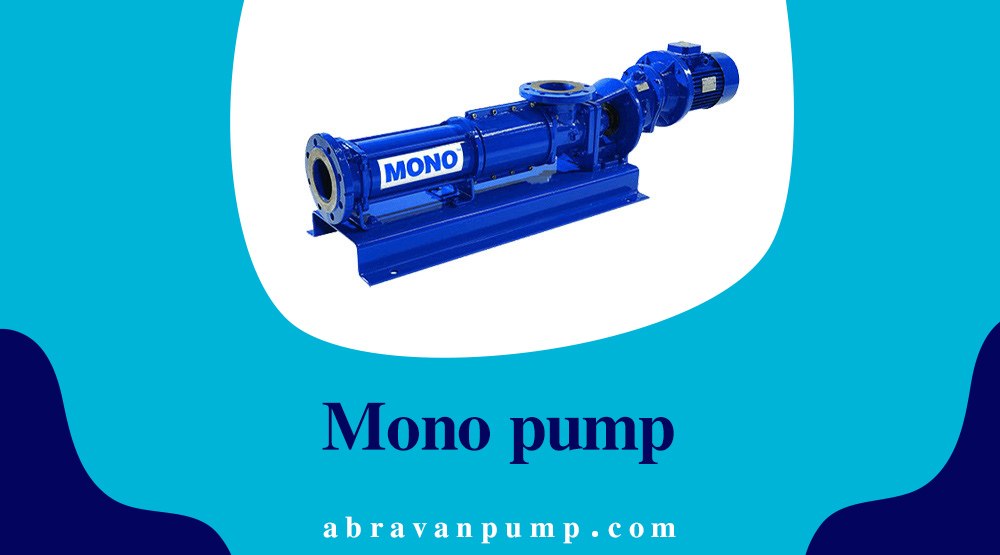A Mono Pump falls under the classification of progressive cavity pumps, which are positive displacement pumps. The Mono Pump is recognized under various alternate names such as cavity pump, single screw pump, helical rotor pump, eccentric screw pump, progressing cavity pump, and Mardoni pump. This pump has specific and unique applications, and having high power and a strong motor are among its other features. In the following, we will further examine this product.
Characteristics of the Mono Pump

Different types of Mono pumps share some common characteristics, including the following:
• Typically, this pump is appropriate for highly viscous and dense fluids and sometimes it is referred to as a thick slurry pump.
• The Mono pump consists of a helical stator, often made of plastic. Inside the helical stator, there is a metal rotor.
• This rotor is placed on a shaft and rotates with the electric motor’s movement, causing the fluid to circulate along the pump’s axis.
• Typically, the capacity of this pump varies between 1 to 150 cubic meters per hour, and its pressure ranges from 6 to 40 bars.
In which industries is the Mono Pump used?
Broadly speaking, the Mono Pump finds application in metering and gauging, water pumping, and the transfer of any type of fluid or liquid with high viscosity, thickness, and stickiness. The Mono Pump is particularly effective for pumping or transferring adhesive fluids. It is also a suitable choice when high efficiency is required along with uniformity, high pressure, and the absence of turbulence.

These pumps find applications in different industries such as chemical, detergents and hygiene, food and beverages, mining, cement, and the petroleum industry. The most important applications include the following:
• Pumping and transferring slurries
• Pumping toothpaste
• Pumping lubricating oil
• Pumping fuel
• Pumping cement or grout
• Pumping and transferring sewage and sludge
• Pumping gelatine
• Pumping and transferring dishwasher fluid
• Pumping honey, cream, chocolate, and sauce
• Pumping thick and viscous chemicals
What are the key benefits of using the Mono Pump?
- The Mono Pump is employed to pump and transfer a variety of fluids and liquids, spanning from viscous and adhesive to more fluid-like consistencies.
- It can also handle multiphase materials.
- It has a low NPSH (Net Positive Suction Head) requirement.
- It generates a uniform and continuous flow, minimizing shear effects.
- Its flow rate is proportional to the motor speed.
- It has a high suction power capability.
- Maintenance and upkeep are straightforward.
- It is suitable for transferring materials with solid particles.
- It has a long lifespan and minimal likelihood of wear.
- It exhibits high resistance to abrasion.
- It operates with low noise.
- It doesn’t require expensive seals.
- It offers high capacity and appropriate pressure levels.
- It is also suitable for dosing applications.
The Mono Pump presents a range of benefits compared to other pumps, including the utilization of more advanced technologies in its production. Additionally, its structure and performance are superior to other pumps, enabling broader applications.
Types of Mono Pumps

A Mono Pump consists of two parts, a rotor and a stator, which result in various types based on the alteration of these two components. Differences in material viscosity, flow rate, and size resulted in the construction of various Mono Pumps. The various types of Mono Pumps, categorized by their operational features and constituent parts, include:
Mono Pump Series P or Standard:
This is one of the most common types of Mono Pumps, also referred to as a pipe pump. The Mono Pump has a pipe-like structure with a simple suction inlet and no helix. This model is mostly used in industries for transferring thick, sticky materials along with solid particles. Its design allows for easy cleaning. Its applications include transferring viscous fluids like honey, syrup, and liquids with solid particles.
Mono Pump Series R:
This type is almost similar to Series P, but it has less wear and higher safety.
Mono Pump Series H or Hopper:
This model is suitable for pumping relatively firm fluids and has a helix. The hopper-shaped design aids in faster fluid pumping. The key difference from other pipe-type models is the presence of a hopper at the inlet of the Mono Pump. The size of the hopper can vary based on the Mono Pump’s capacity.
The components of the hopper-type Mono Pump include the rotor, stator, and a transfer system consisting of a screw-designed shaft, hopper-shaped chamber, coupling, motor, and gearbox. Its operation involves fluid entering the pipe through the hopper, while the internal screw auger facilitates the quick and smooth movement of materials.
One of its primary uses is in the food industry for pumping materials like gluten, apples, various doughs, and more.
Mono Pump Series V or Semi-Submersible:
This model is positioned vertically in the circuit and has high efficiency. This type is more cost-effective than other types. Its main and significant application is pumping highly viscous materials.
Mono Pump Series F or Food Industry:
This type of Mono Pumps is used in the food, pharmaceutical, and hygiene industries. This model adheres to high standards, such as pumping and transferring in completely sterile conditions.
Mono Pump Series C or Compact:
This model of Mono Pump is very small in size and has a simple structure. It is suitable for small spaces and various uses.
What are the constituent elements and components of a Mono Pump, and what is the installation process like?

Each type of Mono Pump generally consists of the following components and parts:
• Stator (Fixed Helix) or Mono Pump Rubber
• Rotor (Rotating Auger) or Mono Pump Auger
• Casing
• Shaft
• Sealing System
• Motor and Gearbox
• Frame
• Casing
Each of these components has a specific function. For example, the rotor takes the form of a long-pitched, thin-threaded helical rod. As the rotor rotates within the stator (off-center), cavities are formed between the rotor and the stator. These cavities continuously move from the inlet to the outlet.
The creation of cavities at the inlet results in the suction of materials into them. Once the cavities are filled, the materials move in a helical path between the rotor and the stator until they reach the outlet. This process is repeated with the rotation of the rotor, causing a continuous pumping of materials.
Installation Method of Mono Pump
The installation of a Mono Pump is crucial and involves complexities that should be carried out by experts. In general, the installation of a Mono Pump consists of several steps, briefly described as follows:
1. A suitable location must be chosen for the installation of the Mono Pump.
2. When installed horizontally, ensure that its bases are positioned on a flat surface to mitigate and minimize noise.
3. Adequate ventilation should be provided for the pumps.
4. Prior to startup, cleaning and lubrication are necessary.
5. The suction chamber should be dry and emptied.
6. The pump and gearbox should be properly aligned.
7. Appropriate coupling and bushing must be incorportated.
What are the drawbacks of a Mono Pump?
The Mono Pump also exhibits certain drawbacks, which encompass the subsequent points:
• Comparatively elevated cost associated with the Mono Pump.
• Reduced head capability.
• Intricate repair and installation procedures.
• Its pumping efficacy experiences significant decline under extremely high temperatures or arid circumstances.
Major Mono Pump Manufacturers
Various factories and brands worldwide engage in the production and distribution of Mono Pumps. Among the most important and well-known producers of this product are brands such as PCM, Prominent, Jesperrger, SEEPEX, Flowserv, Alfa Laval, and Franklin Electric. One of the significant domestic manufacturers of Mono Pumps is the Bohlul Company.

